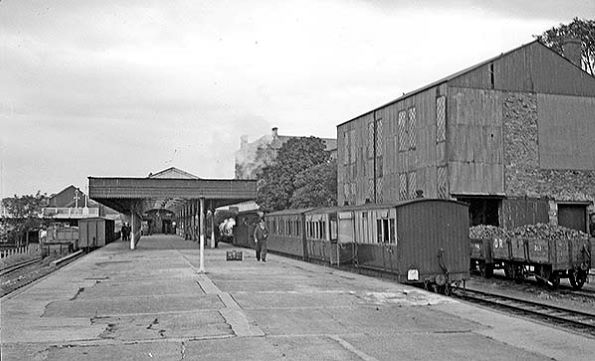 A view looking north along the platform at Londonderry Victoria Road station in the late 1940s. A two coach train from Strabane has just arrived. A view looking north along the platform at Londonderry Victoria Road station in the late 1940s. A two coach train from Strabane has just arrived.
Copyright photo from Ernie's Railway Archive
The walled city of Derry/Londonderry, located on the western side of the River Foyle in the north of Ireland, was established in 1613 and by the mid-19th century it had become an important port and manufacturing centre. A settlement had developed on the east side of the river which was called Waterside and since 1790 there had been a bridge which provided a link to the city (a wooden bridge that was replaced by one of iron, the Carlisle Bridge, in 1863). The first railway to serve Derry/Londonderry had opened on 19 April 1847 and by 18 April 1850 they had established a station at Foyle Road adjacent to the bridge on the city side of the river. This line later became the Great Northern Railway Ireland (GNRI). The next railway to open, on 29 December 1852, the Londonderry and Coleraine Railway made its terminus at Waterside and this line went on to become the Belfast & Northern Counties Railway (BNCR). Both of these lines were built to the Irish standard gauge.
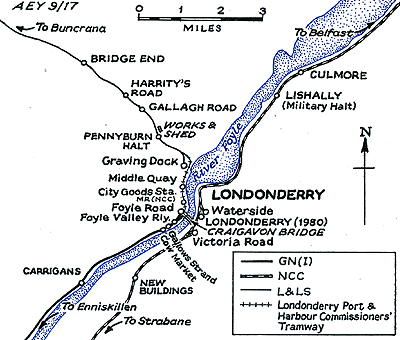 To the west of Derry/Londonderry lay the large county of Donegal. Railways had started to penetrate that county from 1863 and by the 1890s a network of 75 miles of line had been established by the Donegal Railway (DR) company. The DR had a junction with the GNRI line at Strabane and at this time they were sharing that company’s station there. The DR line between Strabane and Stranorlar was 5ft 3inch gauge but everything to the west of that point had been built to 3ft gauge. In 1893 the DR obtained an act to convert the Strabane – Stranorlar line to 3ft gauge and to build their own station at Strabane. The new station served by a re-gauged line opened on 16 July 1894. Whilst these developments improved things for the DR it had only moved the issue of transhipping goods between gauges to a different location (Strabane instead of Stranorlar). To the west of Derry/Londonderry lay the large county of Donegal. Railways had started to penetrate that county from 1863 and by the 1890s a network of 75 miles of line had been established by the Donegal Railway (DR) company. The DR had a junction with the GNRI line at Strabane and at this time they were sharing that company’s station there. The DR line between Strabane and Stranorlar was 5ft 3inch gauge but everything to the west of that point had been built to 3ft gauge. In 1893 the DR obtained an act to convert the Strabane – Stranorlar line to 3ft gauge and to build their own station at Strabane. The new station served by a re-gauged line opened on 16 July 1894. Whilst these developments improved things for the DR it had only moved the issue of transhipping goods between gauges to a different location (Strabane instead of Stranorlar).
Furthermore the transhipment now had to be made between the DR’s wagons and those of a different company (the GNRI) which added further cost. The solution was that the DR build a 14½ mile 3ft gauge line of their own between Strabane and Derry/Londonderry. Although the GNRI objected to a line that would take away some of its business an Act was obtained for its construction on 7 August 1896.
The DR line ran to the east of the River Foyle and had its northern terminus in the Waterside area at Victoria Road (a short distance to the south of the BNCR station which was called Londonderry Waterside). The DR named their terminus station Londonderry Victoria Road. It was located on the eastern bank of the Foyle adjacent to the Carlisle Bridge.
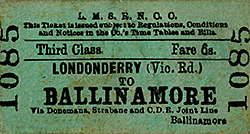 The station was built between 1899 and 1900 by the contractor R Campbell & Son of Belfast to designs drawn by James Barton. The station consisted of a single-storey red brick building which faced onto Victoria Road which ran parallel to the station itself on a higher elevation. To the rear of the building there was an enclosed circulating area followed by a long island platform that had two faces with run round loops for both platforms at first. A canopy extended from the building to the mid-point of the platform. There was also a ramped walkway to the station building on a lower level from a small building on Victoria Road itself. The station was built between 1899 and 1900 by the contractor R Campbell & Son of Belfast to designs drawn by James Barton. The station consisted of a single-storey red brick building which faced onto Victoria Road which ran parallel to the station itself on a higher elevation. To the rear of the building there was an enclosed circulating area followed by a long island platform that had two faces with run round loops for both platforms at first. A canopy extended from the building to the mid-point of the platform. There was also a ramped walkway to the station building on a lower level from a small building on Victoria Road itself.
As one of the primary reasons for building the line was to allow the DR to move goods directly into and out of Derry/Londonderry the station at Victoria Road was provided with extensive goods facilities. There were two goods sidings and a goods loading platform. There was a substantial goods warehouse on 2 levels for the station itself and for Victoria Road on a higher level. The 1904 Handbook of Stations listed Victoria Road as being able to handle general goods, parcels, furniture vans, livestock, horses and private carriages by train. The station was equipped with a 5-ton lifting crane and some cattle pens.
A signal cabin located on the north side of the line just beyond the end of the platform which controlled traffic movements at the station and the station was fully signalled.
A single road engine shed was also provided at the station with two engine sidings, with a turntable and water tower. It was located to the south of the station beyond the signal cabin below Victoria Road itself. The coloured map below shows the station as it was in 1904.
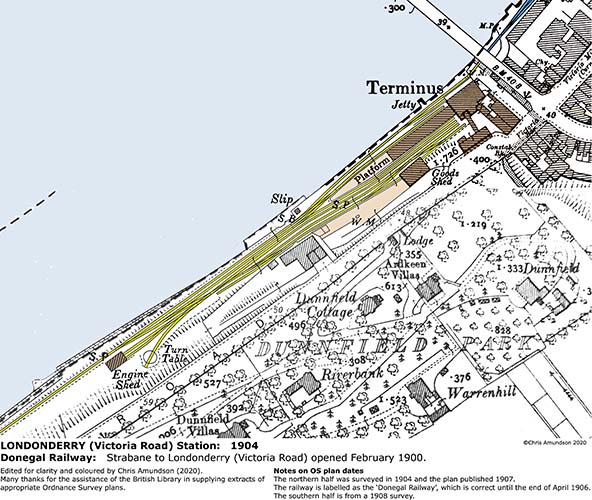
The Carlisle Bridge was a double deck structure that had an upper road deck and a lower rail deck. Since the bridge had opened in 1863 the lower rail deck had been used for transferring goods wagons between Londonderry Waterside station and the City Centre. The DR had a connection to the Carlisle Bridge via sidings on the west side of the station. Mixed gauge track that was provided on the bridge by the Londonderry Port & Harbour Corporation (LPHC) allowed both CDR and BNCR to move their wagons from Waterside to the city. The wagons were moved across the bridge by rope and capstan.
On the west side of the river there was more LPHC mixed gauge track which served the quays and made connections with the GNRI and with the Londonderry & Loch Swilly Railway (opened 31 December 1863). The CDR had their own goods station, City Goods, on the city side of the river, located to the north of the GNRI Foyle Road station. The map below shows the connection between the station and the bridge.
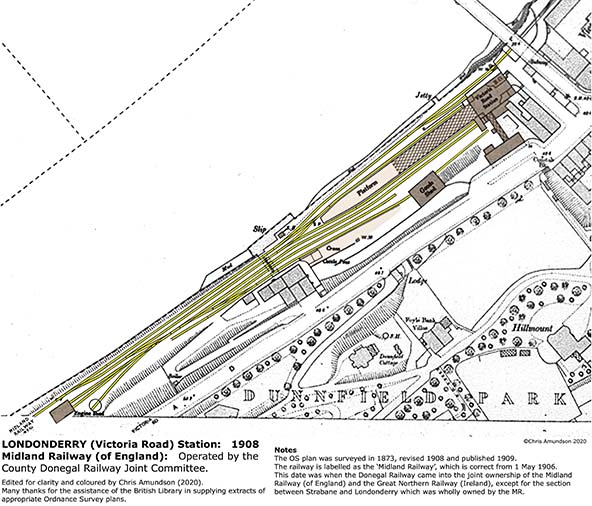
Londonderry Victoria Road station opened for goods services on 1 August 1900 and to passengers on 6 August 1900. At the time of opening from Monday to Saturday there were 6 trains each way between Victoria Road and Strabane and the CDR hoped to develop some commuter traffic along the Finn Valley through to Derry/Londonderry. Trains left Victoria Road from 7.15am to 7.25pm and some of these trains continued to Stranorlar and even Killybegs. In the return direction trains left Strabane for Victoria Road at times from 8.30am to 7.25pm. At this time there were no Sunday services.
In 1903 the BNCR was taken over by the Midland Railway (MR) an English company that wanted to expand into Ireland. The MR was keen to secure access to county Donegal and it sought to purchase the DR. The GNRI was against this and fought the proposal. In the end a compromise was reached which saw, from 1 May 1906, both companies take an equal share in the company which became the County Donegal Railway Joint Committee (CDR). As the GNRI already had a route of its own between Derry/Londonderry and Strabane the Londonderry Victoria Road – Strabane route passed to the MR as a single owner. Station staff at Victoria Road became MR employees. As the station and line were an integral part of the CDR network the train services were provided by that company.
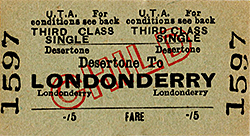 The 1906 timetable showed 6 departures Monday-to-Saturday. The first departure was the 7.20am Stranorlar train. At 9.45 there was another train to Stranorlar followed by a midday service to Strabane. In the afternoon there were trains to Strabane at 3.15pm and 4.45pm. The last train of the day departed at 7.30pm and it ran to Strabane. There were 5 arrivals the last of which arrived at 9.05pm. The 1906 timetable showed 6 departures Monday-to-Saturday. The first departure was the 7.20am Stranorlar train. At 9.45 there was another train to Stranorlar followed by a midday service to Strabane. In the afternoon there were trains to Strabane at 3.15pm and 4.45pm. The last train of the day departed at 7.30pm and it ran to Strabane. There were 5 arrivals the last of which arrived at 9.05pm.
In 1912 a Sunday service of one train in each direction was introduced. There was an arrival from Strabane at 9.00am and a departure for Strabane at 7.00pm. By September 1913 the evening train had been retimed to depart at 9.00pm. The 9.00pm train of Sunday 7 September 1913 met with a serious accident at Donemana due to its crew having spent many hours drinking in the Waterside area during that day (click here to read about and see photographs of the accident at Donemana). After the accident an additional Sunday out and return working was introduced. There was a departure from Londonderry at 7.45am and a return working that arrived at 8.15pm.
In the summer of 1916 a Sunday service was operated from Londonderry Waterside to Ballyshannon. The train departed from Londonderry at 7.45am and was operated for the purpose of taking day trippers to the seaside. It arrived back at Londonderry at 8.51pm.
On 4 August 1914 the British Empire had declared war on Germany and entered the Great War and from 1 January 1917 the CDR was taken under government control (along with all of the other Irish railways). The Sunday services were withdrawn in 1917 and never reinstated. The weekday service was also reduced to four trains in each direction.
In 1919 the Irish War of Independence broke out and it caused much disruption to the CDRJC system. In 1921 a treaty was negotiated which resulted in the island of Ireland being split into two separate countries, the Irish Free State and Northern Ireland which remained as part of the United Kingdom. The majority of the CDRJC lines were located within the Irish Free State but the route between Strabane and Londonderry Victoria Road lay within Northern Ireland. This caused difficulties for the company which were exacerbated by the outbreak of the Irish Civil War (1922-23) which caused even more disruption. The least disrupted of the lines was the Londonderry Victoria Road – Strabane line on which no major incidents were recorded as it ran through a mainly Unionist area.
On 1 January 1923 the MR became part of the London Midland & Scottish Railway and they referred to their Northern Ireland operation as the London Midland & Scottish Northern Counties Committee (LMS NCC). The CDR therefore became a joint concern of the GNRI and the LMS NCC.
By the late 1920s the political upheavals had settled down but competition from road transport began to have an impact. To make economies the CDRJC was an early advocate of diesel power. It introduced diesel railcars onto the lines to the west of Strabane but the Londonderry line continued to be worked by steam locomotives.
In 1933 the Carlisle bridge was replaced with the Graigavon bridge. The new bridge was also a double deck structure with rails on the lower deck.
In 1934 the engine shed at Londonderry Victoria Road was closed (it was demolished during rationalisation in 1946) and the passenger service was reduced to three trains in each direction. There were departures for Strabane at 7.55am, 11.05pm and at 3.10pm. Arrivals from Strabane were at 10.00am, 2.00pm and 6.00pm.
 Under the ownership of the LMS the line had become the responsibility of the NCC who operated their lines in Northern Ireland. By the 1930s the NCC had an agreement to pay the CDR for the running costs of 3 services each way from Monday to Saturday. With no financial incentive to economise the CDR who operated the service on behalf of the NCC retained steam. In 1939 the CDR reduced the use of steam locomotives on the lines to the west of Strabane even further and the steam locomotives that did remain in daily service were timetabled to visit Victoria Road station to receive coal which the CDR did not have to pay for (this practice continued until the closure of the line). Under the ownership of the LMS the line had become the responsibility of the NCC who operated their lines in Northern Ireland. By the 1930s the NCC had an agreement to pay the CDR for the running costs of 3 services each way from Monday to Saturday. With no financial incentive to economise the CDR who operated the service on behalf of the NCC retained steam. In 1939 the CDR reduced the use of steam locomotives on the lines to the west of Strabane even further and the steam locomotives that did remain in daily service were timetabled to visit Victoria Road station to receive coal which the CDR did not have to pay for (this practice continued until the closure of the line).
During the Second World War (1939-45) the CDR saw an upturn in traffic. There was a high volume of cattle movements from the Irish Free State to Londonderry. Because the GNRI main line between Londonderry Foyle Road and Strabane passed through the Irish Free State it could not be used for the movement of war materials or troops (the Free State being a neutral country). The Londonderry Victoria Road and Strabane line was located entirely within Northern Ireland and consideration was given to making it dual gauge (3ft and 5ft 3in) so that GNRI trains could reach Londonderry without having to pass through the Irish Free State. In the end the idea proved to be too complicated and all war related traffic had to operate via the LMS NCC main line This increase in wartime traffic led to the need for a better connection to the NCC station at Waterside. During the early years of the war one of the mixed gauge sidings at Victoria Road was converted to the Irish standard gauge to improve interchange of goods traffic and the connecting line to the bridge was converted to mixed gauge.
In 1946, after the War had ended, the NCC rationalised the Victoria Road – Strabane line. At Victoria Road station the signal cabin was closed and replaced by a ground frame. The signal cabin had been demolished by 1947.
The LMS timetable for 1946 showed that there were still 3 trains in each direction Monday-to-Saturday (see below).
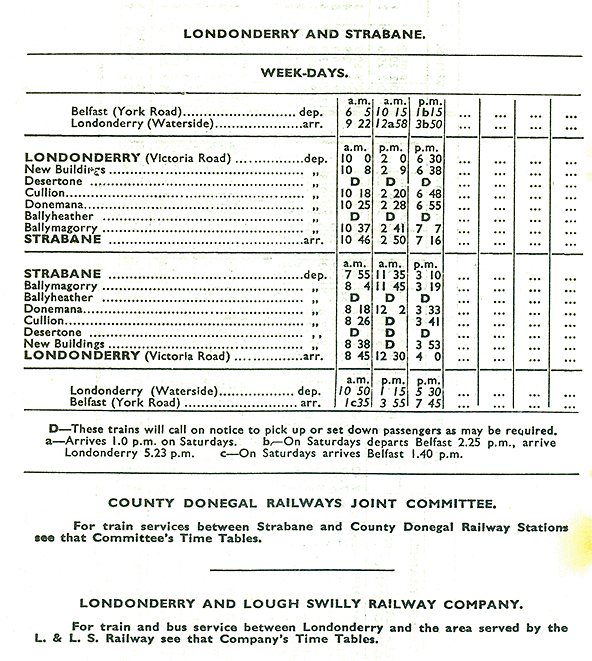
In April 1949 the LMS NCC was nationalised by the Northern Ireland Government and placed under the Ulster Transport Authority (UTA). This meant that Londonderry Victoria Road station and the line to Strabane became part of the UTA. The other CDRJC lines became a joint concern of the GNRI and British Railways (the GNRI was not nationalised as its network was located in two countries). In 1949 the Irish Free State became the Republic of Ireland.
The CDR continued to operate the train services between Londonderry Victoria Road and Strabane which remained at three trains in each direction using steam locomotives.
The station turntable was noted as being disused in 1951 and in 1952 it was moved to Rossnowlagh to be used by CDR railcars for working excursion traffic (see 1950s map below).
By 1953 the GNRI had become financially unviable. It was taken into the joint ownership of the Republic of Ireland and the Northern Ireland Governments and operated as the Great Northern Railway Board (GNRB).
The UTA was a notoriously anti-rail organisation and it had been closing lines throughout Northern Ireland since its inception (on 16 January 1950 it had closed almost the entire network of the Belfast & County Down Railway). The UTA had no use for the Londonderry Victoria Road – Strabane line which it considered to be a duplicate route (there being the Londonderry Foyle Road – Strabane route of the GNRB). The passenger service was withdrawn on 31 December 1954. The last passenger train was a Londonderry to Strabane service and it had to be strengthened to seven coaches to cope with the number of passengers who wanted to have a last ride along the line. It departed from Victoria Road at 7.05pm.
On Thursday 30 June 1955 a Sunday school special was run from Strabane to Londonderry (where the 600 passengers made the short walk to Londonderry Waterside for onward travel to Portrush). Because no trains had run since 31 December 1954 an engine was run along the line the previous day to ensure that it was safe to use.
On 23 September 1955 the UTA announced its intention to abandon the line completely. Most of the track had been lifted by 20 November 1955.
 Londonderry Victoria Road station was later taken over by a firm of wholesale grocers who retained the platforms and the canopy stanchions as part of their new facilities. The starting signal on the platform was retained and if it was in the “off” position they were open for business. Londonderry Victoria Road station was later taken over by a firm of wholesale grocers who retained the platforms and the canopy stanchions as part of their new facilities. The starting signal on the platform was retained and if it was in the “off” position they were open for business.
In 1958 the GNRB was wound up and the network was divided between the UTA and the CIE (the Republic of Ireland’s nationalised railway company). This brought about the end of the CDR as a railway operation, the last section of line (between Strabane and Killybegs) closing on 1 January 1960. The closure did not end there as on the 15 February 1965 the UTA also closed the former GNRI route from Londonderry Foyle Road. Only the former NCC line between Londonderry Waterside and Belfast survives to this day.
For a brief period in the early 1970s rails returned to Victoria Road station when it became the home of the North West of Ireland Railway Society (NWIRS) from 1974 till 1979. They laid track at the station site and brought in a locomotive, number 6, some rolling stock and railcar 18. In 1979 the business that owned Victoria Road became insolvent and the NWIRS tried to get Derry City Council to purchase the station site. When the station site came up for sale it was purchased by another local business as the Council failed to assist the NWIRS. The new owners told the NWIRS to remove all the rolling stock from Victoria Road and all rolling stock was moved to the now closed Shanes Castle Railway for storage. By 1989 the society had moved to the other side of the River Foyle to the Foyle Valley Railway Museum until 2000.
In 2020 Londonderry Victoria Road station was extant and was being used as a bathroom showroom. The buildings alongside Victoria Road still remain including the former goods store.
Coloured maps by Chris Amundson |

 Home
Page
Home
Page

 Home
Page
Home
Page